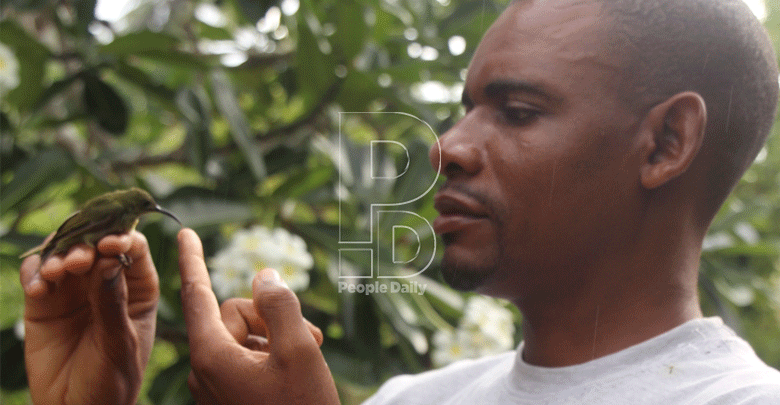Bird protectors of Kilifi

With dwindling numbers of birds around Arabuko Sokoke, Mida Creek and Dakacha, a group of residents are doing their part to ensure they are protected from threats.
Harriet James @harriet86jim
Every Tuesday morning, bird lovers converge at the Mwamba Field Study Centre in Watamu, to participate in ringing process.
They check out birds caught in the mist nets which range from six to 12 metres due to the habitat.
The activity, led by A Rocha, a Christian global organisation, that conducts research and teaches people on the value of conservation, takes place from 6am to 10am during which participants assist in ringing birds, and learn about the habitat and conservation activities the organisation carries out.
“One of the most important information we collect is the age of the bird and from that we can get the percentage of the juveniles and adults, and breeding success for the year.
The age of a bird is important in understanding its biology and conservation,” explains Colin Jackson, founder of A Rocha Kenya.
“If we catch no juveniles then we know they didn’t breed because maybe the conditions were bad or there was no food or it was flooding. 
But if we have them in plenty, it means there was a great breeding season. You can also tell of survival from one year to the next and the age of the bird by the few juvenile features it may have,” he adds
Habitat affected
A Rocha, which means rock in Portuguese, was formed in 1983 by Miranda and Peter Harris as a worldwide organisation to protect the environment through local, community based conservation, environmental education as well as scientific research.
It has five guiding principles which are Christian, conservation, community, cooperation and cross cultural. As of 2016, it had spread to several countries.
In Kenya, the movement was founded by Colin. Born and raised in Kijabe, he travelled to the UK to study and later on toured Portugal where he met the Harrises and volunteered at A Rocha.
His interest in conservation began and when he came back in 1998, he began researching areas where nature was in danger of extinction.
He found out that in places such as Arabuko Sokoke, Mida Creek, Sabaki, Dakacha and the Tana Delta some species are in danger of extinction.
Besides the conservation efforts at the coast, they have a project in Nairobi called Karara, where they plant indigenous trees and carry out environmental education and community conservation.
“We talk with the people surrounding the areas because their activities directly affect these habitats.
We chose Arabuko Sokoke because it’s a remnant of what used to be a very long stretch from Mozambique to Southern Somalia, but has now reduced to only 420sq km. 
It is like an island surrounded on every side by humans threatening its existence,” explains Lennox Kirao Kipe, a researcher at the organisation.
In the forest, there are unique species such as the golden-rumped elephant shrew —or fugu in the local dialect— which is endemic to Kilifi county. The mammal is found in Gede Ruins and Dakacha.
There is also the Clarke’s weaver bird, an endangered species, which, according to research carried out in 2013, have their own and only breeding grounds in the whole world in Dakacha.
Endangered species
“We have six globally endangered species living in Arabuko Sokoke either because their population is very small or their habitat is dwindling.
For instance, sokoke pipit, ground thrush, a migrant from South Africa, sokoke scops owl, East Coast akalat and amani sunbird,” notes Kirao.
Since Arabuko Sokoke is a government reserve protected by the government, their main focus area has been Dakacha, which is a community land.
Five or six years ago, people began selling their land in favour of pineapple plantation, and as a result, forests have been cleared and charcoal burnt.
“The sokoke scops owl has made this place its habitat and such activities mean that they will be extinct in a few years. We are trying to purchase land and make the area a reserve.
So far we have bought 1,400 acres and we are still seeking for money to buy the land so that even if people cut trees in other areas, there will still be a small section intact where these endangered species can call home,” explains Kirao, one of the beneficiaries of Arabuko Sokoke Schools and Eco tourism Scheme (ASSETS) founded by A Rocha in 2001.
They are also training the community on economical ways of agriculture dubbed “farming God’s way”.
“Natural forest will do very well without any effort and we are trying to research why forest habitat thrives and grows without much effort from humans.
We are trying to take that example of zero tillage, crop rotation, mulching and to train the farmers on it.
We are also advocating for the use of just one acre and leaving the rest. They have been doing that for four years now and the returns have been great,” says Kirao.
Like any other conservation work, one main challenges has been funds since they rely on grants.
Also convincing people to conserve their habitat has not been an easy task as there are no alternative economic activities to make them turn away from the harmful actions against the environment.
“It’s quite hard to change a habit that has been entrenched over years. We need to walk with them for a long time and that calls for a lot of patience.
While people know trees are beneficial, poverty makes them go back and cut them to earn a living and feed their families as the rewards of conservation are not immediate,” Kirao says in conclusion.



